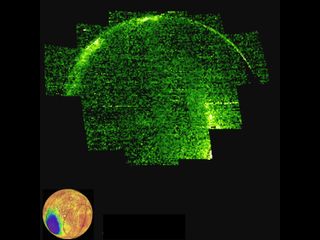Gorgeous Mars 'Nightglow' Spotted by NASA Orbiter (Photos, Video)
The first detailed look at Martian "nightglow" has been revealed, thanks to the work of NASA's newest Red Planet orbiter.
The space agency's Mars Atmosphere and Volatile Evolution (MAVEN) probe took global pictures of the Red Planet in ultraviolet (UV) light, revealing how winds flow at high altitudes. You can see a video of the UV nightglow on Mars here.
"Nightglow" refers to a phenomenon in which a planet's sky faintly glows, even without external light. On Mars, this is the result of nitric-oxide emissions. [Photos: NASA's MAVEN Mission to Mars]

These emissions are produced when UV light from the sun breaks down carbon dioxide and nitrogen molecules on the day side of Mars. High-altitude winds circulate the remaining atoms across the planet. On the Martian night side, the atoms flow down to lower altitudes, where nitrogen and oxygen atoms combine and create nitric oxide. The resulting energy the combination creates is released as UV light.
While nightglow has been detected by earlier missions, MAVEN is the first to show images of it in action.
"Splotches and streaks appearing in these images occur where [nitrogen oxide] recombination is enhanced by winds. Such concentrations are clear evidence of strong irregularities in Mars' high-altitude winds and circulation patterns," NASA officials said in a statement.

"These winds control how Mars' atmosphere responds to its very strong seasonal cycles," they added. "These first images will lead to an improved determination of the circulation patterns that control the behavior of the atmosphere from approximately 37 to 62 miles (about 60 to 100 kilometers) high."
Get the Space.com Newsletter
Breaking space news, the latest updates on rocket launches, skywatching events and more!
Besides showing nightglow, MAVEN's new UV images reveal how ozone changes seasonally, and that clouds are formed over huge Martian volcanoes, mission team members said.

Daylight images of the Martian south pole were obtained, showing that ozone persists longer in the southern hemisphere than previously believed. While ozone breaks down when water vapor is introduced, the global winds of Mars keep the water vapor away well into the spring.
MAVEN's images of clouds over four Martian volcanoes are some of the best a mission has taken, NASA officials added. Monitoring clouds helps scientists understand how a planet regulates its energy and water vapor over each day and season.
These results will be presented tomorrow (Oct. 19) at the American Astronomical Society Division for Planetary Sciences meeting in Pasadena, California, by Nick Schneider, an associate professor at the Laboratory for Atmospheric and Space Physics at the University of Colorado.
Follow Elizabeth Howell @howellspace, or Space.com @Spacedotcom. We're also on Facebook and Google+. Original article on Space.com .
Join our Space Forums to keep talking space on the latest missions, night sky and more! And if you have a news tip, correction or comment, let us know at: community@space.com.

Elizabeth Howell (she/her), Ph.D., is a staff writer in the spaceflight channel since 2022 covering diversity, education and gaming as well. She was contributing writer for Space.com for 10 years before joining full-time. Elizabeth's reporting includes multiple exclusives with the White House and Office of the Vice-President of the United States, an exclusive conversation with aspiring space tourist (and NSYNC bassist) Lance Bass, speaking several times with the International Space Station, witnessing five human spaceflight launches on two continents, flying parabolic, working inside a spacesuit, and participating in a simulated Mars mission. Her latest book, "Why Am I Taller?", is co-written with astronaut Dave Williams. Elizabeth holds a Ph.D. and M.Sc. in Space Studies from the University of North Dakota, a Bachelor of Journalism from Canada's Carleton University and a Bachelor of History from Canada's Athabasca University. Elizabeth is also a post-secondary instructor in communications and science at several institutions since 2015; her experience includes developing and teaching an astronomy course at Canada's Algonquin College (with Indigenous content as well) to more than 1,000 students since 2020. Elizabeth first got interested in space after watching the movie Apollo 13 in 1996, and still wants to be an astronaut someday. Mastodon: https://qoto.org/@howellspace
